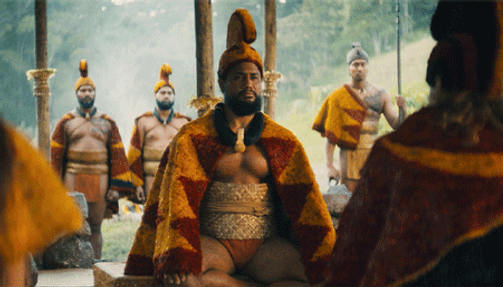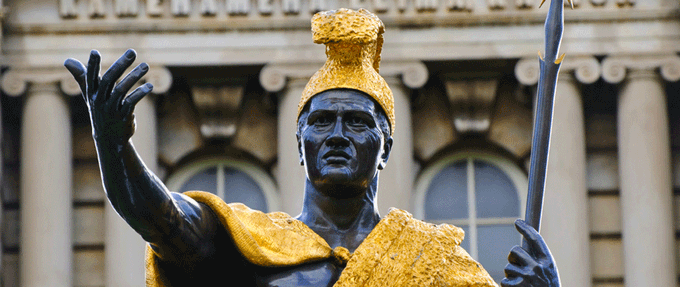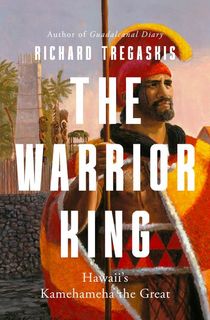On August 1, 2025, Jason Momoa premiered a new Apple TV+ series called Chief of War. Besides starring in the show, Momoa also co-created and co-wrote the series with Thomas Pa’a Sibbett. While it takes considerable liberties with its story of the unification of Hawaii under the rule of Kamehameha I, the series has been largely praised for its accuracy, with a 93% on Rotten Tomatoes, where the critics consensus reads, “Starring Jason Momoa at his ferocious best, Chief of War is a brutal epic that recreates Native Hawaiian history with commendable authenticity.”
In the series, Momoa plays Ka’iana, one of several significant historical figures who fought both against and alongside Kamehameha in his quest to unify the Hawaiian Islands under his rule. But what of those who want a more bird’s-eye view of the unification of Hawaii under its first king?
Overturning the Naha Stone: The Rise of Kamehameha I
No one knows for certain when or where Kamehameha I was born, though most accounts place his birth between 1736 and 1761, on the northwest peninsula of the island of Hawai’i. Raised in the royal court of his uncle, Kalani’opu’u, Kamehameha was named the guardian of the god of war, Kuka’ilimoku – but Kamehameha was destined for greater things yet.
In Hilo, on the island of Hawai’i, there was a prophecy about a large volcanic rock called the Naha Stone. Estimated to weigh between 2.5 and 3.5 tons, the prophecy said that anyone who could overturn the stone would “lift off the strands that bind the islands,” and be capable of uniting the entire archipelago under one rule. It was believed that anyone who could move the stone had the “mana, or spiritual power, to rule the land.”
According to some accounts, Kamehameha was able to overturn the Naha Stone by the time he was fourteen. At that time, the archipelago was divided under the rule of several monarchs, with borders that would shift in the coming years through conquest and civil war. However, Kamehameha was inspired by the prophecy, and several other important figures believed that he was the man to achieve it, and ultimately bring the entire island chain under one ruler.
Gunpowder and the Olowalu Massacre
In 1789, fur trader Simon Metcalfe and his son Thomas were captaining two ships, the Eleanora and the Fair American, respectively, which were intended to rendezvous in Hawaii. The Eleanora arrived first, and an interaction between Simon Metcalfe and Chief Kame’eiamoku went wrong. Later, while docked in Maui, a small boat went missing from the larger ship. Metcalfe believed that it had been stolen by islanders, with a crewman inside who was subsequently murdered.
Metcalfe took his revenge on the village of Olowalu, where he first initiated the usual greetings to the locals, and then opened fire with all his ship’s cannons when the residents of the village had gathered on the beach, killing more than one hundred. Vengeance begets vengeance, however, and Chief Kame’eiamoku attacked the next foreign ship that arrived, which in this case was the Fair American. Kame’eiamoku’s soldiers killed Metcalfe’s son and all but one of the five crewmen.
Isaac Davis, the only survivor of the Fair American, and John Young, a captured boatswain from the Eleanora, eventually settled on the islands, where they were treated as chiefs and aided Kamehameha’s unification efforts. They weren’t the only ones. Kamehameha also had the captured Fair American, and thanks to trading relationships with individuals such as Captain William Brown of the Butterworth Squadron, he had access not only to gunpowder, but to the formula for making it, which required ingredients that were abundant on the islands.
These tools helped Kamehameha extend his rule across the island chain, beginning with Maui and Moloka’i. By 1810, Kamehameha had become the first ruler of the unified Kingdom of Hawaii, but he didn’t achieve his conquests entirely with spears, guns, and cannons. Diplomacy and spiritual authority also helped him ascend to his position.

King Kamehameha in The Warrior King.
Photo Credit: Apple TV+The Law of the Splintered Paddle
Kamehameha I ruled Hawaii for many years. He had more than twenty wives, and many children. Kamehameha’s children and grandchildren would continue to rule the kingdom for most of its existence, and a descendant of Kamehameha sat on the throne until 1874. The Kingdom of Hawaii was toppled just 21 years later, when Queen Lili’uokalani was overthrown with plans to annex the island to the United States, which happened in 1898, though Hawaii would not become the 50th state until 1959.
One of the most lasting legacies Kamehameha left behind, however, is still evident in Hawaii's state constitution. Sometimes known as the Law of the Splintered Paddle, it begins when Kamehameha was on a military expedition in Puna. There, as he was pursuing two fishermen, one struck him on the head with a paddle so hard that the paddle itself shattered, and Kamehameha was rendered unconscious. Rather than killing him, however, the fishermen left him.
When these same fishermen were later brought before Kamehameha, he apologized to them and gave them gifts, saying that he had been in the wrong for attacking innocent people. This was the beginning of Kanawai Mamalahoe, or the Law of the Splintered Paddle, which states, “May everyone, from the old men and women to the children, be free to go forth and lie in the road without fear of harm.”
Kanawai Mamalahoe codified an existing tradition regarding how the government should treat its people and has since become a model for human rights law around the world. Besides its enshrinement in the state constitution, the Law of the Splintered Paddle is evident throughout modern Hawaiian culture, including in the crossed paddles on the badges of the Honolulu Police Department.
The Warrior King
This has been a necessarily brief overview of the rise, the reign, and the legacy of Kamehameha, the first King of Hawaii. The history of this island nation turned 50th state is a rich and fascinating one, and one place to go to learn more about the life, the ascendance, and the rule of Kamehameha is The Warrior King, a detailed biography of Kamehameha I by New York Times-bestselling author Richard Tregaskis, which gets into many of the nuances that we simply didn’t have room for here.
Feature image: Joel Carillet / Canva

